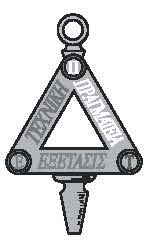JOTS v36n2 - Networking Labs in the Online Environment: Indicators for Success
Networking Labs in the Online Environment: Indicators for Success
Hilmi A. Lahoud and Jack P. Krichen
Abstract
Several techniques have been used to provide hands-on educational experiences to online learners, including remote labs, simulation software, and virtual labs, which offer a more structured environment, including simulations and scheduled asynchronous access to physical resources. This exploratory study investigated how these methods can be used from the learner's perspective to enhance the online learning experience by improving its effectiveness and maintaining students’ satisfaction while keeping the same level of standards and outcomes as face-to-face courses. Current and former online learners from several community and four-year colleges were surveyed to evaluate their experiences for utilizing different networking lab techniques. An analysis of survey results highlights the importance of lab accessibility to learner satisfaction and evaluates the interaction between learner experience and preference for networking labs. These results are used to recommend the best implementation practices and to guide future studies in online networking labs.
Introduction
Hands-on experience with network equipment is an essential aspect of learning computer networks, and historically it has been the mode of preparing professionals for careers in this field. It reinforces the conceptual framework of this discipline and provides the real-world experience demanded by employers in these professions ( Nurul, 2006 ). The evolution of online learning and economic constraints have prompted the development of remote computer network laboratories and network simulation programs that closely mimic the operation of corporate computer networks ( Lawson & Stackpole, 2006 ; Wong, Wolf, Gorinsky, & Turner, 2007 ) . To effectively prepare learners to transfer their learning in these environments to the enterprise, it is essential to compare the traditional network learning environment and the remote and virtual “simulated” environments. In particular, the impact of using an online learning context in conjunction with these lab scenarios must be explored because of the expanding number of online networking programs. Research exists that explores these relationships from the learner outcome perspective, but does not clearly indicate what aspects of the lab environments or learner characteristics might be related to these outcomes ( Lawson & Stackpole, 2006 ). Because the online educational context can provide a flexible environment to accommodate individual learning characteristics, discovering these characteristics and the affect they have on learning will enable the development and maturation of more effective network labs.
Background
From the early days of distance learning, commonly referred to as Distance Education, and current online educational environments (elearning), teaching technical courses remotely has been a challenge. Educational institutions tried different aspects of teaching remote courses using hybrid methods, including video demonstrations, offline network laboratories, and other activities utilizing both synchronous and asynchronous teaching techniques within the same course while attempting to include experiential-based learning activities. Although the importance of providing experimentally based, hands-on learning in the online environment was acknowledged, providing this experience complicated technical support, and often required that learners purchase course-related equipment to perform the activities to master network competencies ( Lahoud & Tang, 2006 ). Therefore, it has been challenging to offer networking courses online because of the need for hands-on experience and the high cost of networking equipment, particularly if it could not be shared ( Ma & Nickerson, 2006 ).
Technological advances during the last several years have supported the development of high-quality network simulations ( Boson, 2008 ) and the sharing of expensive network equipment through Internet-based remote labs ( Network Development Group, 2009 ). Remote labs became more popular because of the power of personal computers and the speed of the Internet ( Border, 2007 ; Rigby & Dark, 2006 ; Schumann, 2003 ). According to Corter, Nickerson, Esche, Chassapis, Im, & Ma (2007) , remote labs proved to be an effective tool in providing hands-on laboratory experiences to students.
As theses options became available, educational institutions, training centers, companies, and even individuals began exploring alternatives to purchasing real equipment to support computer labs. Instead, they explored simulations and remote labs for their educational and training needs ( Schumann, 2003 ; Watts & Becker, 2008 ). When these alternatives evolved (i.e., remote labs and simulation software), educational institutions began to use such software to offer technical courses online. Supporting this initiative, publishers often bundle virtual labs with their textbooks to attract educational institutions to select their books ( Ma & Nickerson, 2006 ). Educational application developers are currently using state-of-the-art software and hardware to continue to enhance remote and virtual labs and improve the fidelity of simulations to emulate equipment and provide high-quality, cost-effective solutions for networking labs.
Unfortunately, those who use simulations and remote labs often have not considered the individual differences between learners and the characteristics of labs on the success or satisfaction of the learning experience. Individual experiential differences and differences in learning styles can affect the learners’ level of satisfaction and overall performance in many ways ( Corter et al., 2007 ). According to Corter and colleagues (2007) , students in engineering fields performed better in traditional settings that involved interpersonal and instructor interaction. Additionally, they were more satisfied with traditional labs than remote labs or simulation-based labs. However, little research about this issue exists relative to computer networking courses and supporting labs, particularly in the online context.
This study is an attempt to better understand how learner characteristics, particularly students’ prior educational experience and career disposition, might affect their satisfaction with types of networking labs. Because the study focuses on adult learners, the tenants of adult learning theory provide the basis for the study and the analysis of the study’s results. According to Adragogy, adult learning theory ( Knowles, Holton, & Swanson, 2005 ), adults learn best and are most satisfied when learning experiences align closely with their prior life experiences. Tennant and Pogson (1995) emphasize the importance of linking to learners’ prior experience; however, these authors challenge such students with learning activities to help them acquire new competencies (pp. 153–169). Adult learners prefer a more flexible learning environment where they can both reflect on the material and apply it to their lives ( Tennant & Pogson, 1995 , pp. 121-147). This study explored both tenants; its authors focused on the flexible online context while incorporating the experiences learners have had in both the traditional and online settings. They attempted to determine which aspects of the labs are most relevant to learner satisfaction by comparing participants with experience in networking and online education with those who had limited experience in these areas. Results that differed from those expected according to the above precepts may indicate areas for improvement in the alignment of labs to types of learners. This information could guide in the development or use of labs to improve their acceptance by students.
Online Learning and Lab Options
First, the key types of network labs will be considered. Online institutions use several options to offer experiential learning with network labs ( Adams, 2004 ; Brown & Lahoud, 2005 ; Lahoud & Tang, 2006 ), including the following:
- Institutions provide/maintain their own labs.
- Institutions contract such task to a third party to provide such a service.
- Institutions ask learners to purchase their own simulation software to be installed on their own computers.
These options encompass several types of remote network laboratory learner experiences. However, two represent the majority of the research in this area and are most used in educational practice ( Ma & Nickerson, 2006 ), simulation software and remote networks labs. These options are the focus of this investigation.
Simulation Software
The first category includes network simulators, similar to the Boson (2008) network simulator (NetSim™), that provides a realistic emulation of network hardware, network configuration, and realistic usage scenarios (virtual routing tables, etc.). Simulators are cost effective compared to a laboratory of network hardware and can be utilized in a shared resource environment. However, as simulations, they do not provide the exact interface and behavior that is available when using the actual hardware. This is particularly evident when exploring error conditions where a user may issue an improper or unexpected command. The real hardware will provide the actual response to the situation, but a simulation often will not provide the true response since it may represent an unexpected scenario.
The characteristics of simulators that may align with learner characteristics include fidelity or degree of similarity to the actual network environment. It is postulated that the fidelity of simulators would rank between a physical network laboratory and a remote virtual laboratory. The accessibility of the simulator is also a concern for the learner. This characteristic is related to the simulator’s ability to be used on a learner's computer or accessed through a browser and Internet connection. The later use may involve an additional level of user interface. The usability of a simulator must be considered from the perspective of how accessible or intuitive is the interface.
Simulators include the option to purchase the software, and thus the student would own it after the course is finished. One of the advantages of using “owned” simulation software is the convenience of being able to perform the labs at any time without the need to schedule a time and/or access the Internet to utilize the simulation; learners are able to complete their assignments while they are traveling as long as they have access to a laptop that contains the simulation application.
Remote Labs
Remote network laboratories comprise the next group of learning environments. These laboratories support shared learner access to physical network equipment through an Internet interface. Depending on the interface used to access the hardware, this experience of configuring, maintaining, and troubleshooting a network environment is close to the experience in a true campus network ( ElementK, 2008 ). The interface that mediates access to the physical hardware is responsible for the quality of the learner experience ( Wong et al., 2007 ). Wong et al. (2007) indicated the interface may improve the accessibility of the labs for learners who have had little prior network experience. Additional software is often used to augment the environment through reporting services that provide a detailed analysis of network behavior ( Wong et al., 2007 ).
Accessibility is a key consideration of these labs. Because actual network hardware is used and must be shared among learners, these laboratories are expensive. Often a reservation system is used in an online education setting to support scheduling the hardware and to control learner access; this also tracks the experience of learners who use the laboratory environment. Even though remote labs are usually used by individual learners, some remote lab settings allow learners to work on the same environment simultaneously and co-operationally, as if they were managing a real network. This provides a close representation to a traditional collaborative laboratory environment.
To mitigate expense and to improve accessibility, remote labs have been enhanced by reducing the number of required hardware components through the use of virtual software, such as VMware™ . Virtual software applications provide layers of working environments, which allows learners to install several operating systems and applications on the same computer ( Golden, 2008 ). Even though this is a breakthrough in teaching operating systems and applications, it is still challenging when teaching configuring devices, such as routers, switches, firewalls and other network equipment.
With an understanding of the history, rationale, and characteristics of key types of network lab environments, it is now beneficial to analyze the relationship of learners’ characteristics compared to each type of environment.
Methodology
Learners’ satisfaction with using remote labs compared to using simulation software was evaluated from the perspective of how learner characteristics and past experience relate to preferences for a type of network lab. This study also investigated which aspects of the laboratory experience were most essential to learners and if those lab characteristics had a relationship to learner characteristics or prior experience. Learners from several online and traditional colleges and universities were invited to take an online survey. Participants were currently enrolled, were former Information Technology (IT) learners who had completed at least one online technical class, and were familiar with both online labs and simulation software. Participants completed IT-related classes from different accredited institutions, and they represent different demographics (age groups, level of education, gender, and years of experience). The names and the personal information of participants were optional. Participants were under no pressure to complete the survey. Participants were contacted via electronic mail and were given one week to complete the online survey. The survey and data were hosted online at www.speedsurvey.com. A password was needed to access the survey, and a mechanism was put into place to prevent participants from taking the survey more than one time from the same computer. Data was downloaded and analyzed using Microsoft Excel.
The survey included 10 questions that focused on the demographic, work, and educational experiences of the participants. Additionally, 13 Likert-style formatted questions were used to ascertain the participants’ level of satisfaction with types and characteristics of networking labs. Two open-ended questions explored other aspects of the network lab environment. This survey is exploratory in nature and has not been validated or aligned with other instruments evaluating satisfaction with lab characteristics. It serves as a potential baseline for investigation in this area. A copy of this survey will be provided upon request.
Results
Demographics and Experience
The demographics of the participants are illustrated in Table 1. Fifty-five individuals participated in the survey, including 33 males (60%) and 22 females (40%). The majority of participants were over 31 years of age. The discipline area of the learners included: 18 IT related (33%), 16 networking (29%), 9 business (16%), and 12 in other disciplines (22%). The majority of the participants specified that networking or information technology was their discipline area: 34 (62%). However, most participants indicated general IT related 18 (33%) as their primary area of interest. As illustrated in Table 2, the participants had substantial experience in the networking profession; 34 (62%) had over three years of experience in networking technology.
| Gender: | n | % | Age Groups: | n | % | Discipline Areas: | n | % |
|---|---|---|---|---|---|---|---|---|
| Female | 22 | 40.0 | 0-20 | 0 | 0.0 | IT Related | 18 | 32.7 |
| Male | 33 | 60.0 | 21-30 | 17 | 30.9 | Networking | 16 | 29.1 |
| Total | 55 | 100.0 | 31-40 | 16 | 29.1 | Business | 9 | 16.4 |
| 41-50 | 14 | 25.5 | Other | 12 | 21.8 | |||
| 51-60 | 8 | 14.5 | Total | 55 | 100 | |||
| Total | 55 | 100 |
| Years | n | Percentage |
|---|---|---|
| 0 | 12 | 21.82% |
| 1-2 | 9 | 16.4% |
| 3-4 | 10 | 18.2% |
| 5-6 | 6 | 10.91% |
| 7 or More | 18 | 37.2% |
| Total | 55 | 100.0 |
From an educational experience perspective, the sample population had more experience with traditional courses than with online courses (Table 3). This table illustrates the number of both online and traditional courses taken by participants. It is apparent from that 24 (45%) had taken more than three courses in an online environment, indicating good participant background in online learning; thus, they could provide useful information for this study.
| Traditional Courses | Online Course | |||
|---|---|---|---|---|
| Number of Courses | n | % | n | % |
| 0 | 0 | 0.0 | 9 | 16.4 |
| 1-2 | 13 | 23.6 | 22 | 40.0 |
| 3-4 | 23 | 41.8 | 16 | 29.1 |
| 5-6 | 12 | 21.8 | 6 | 10.9 |
| 7 or More | 7 | 12.7 | 2 | 3.6 |
| Total | 55 | 100.0 | 55 | 100.0 |
As indicated in Table 4, participants also had considerable experience in networking courses; 35 (64%) had taken three or more of these courses. They also had experience with courses of all three lab types, as indicated in Table 5, but most had more experience with traditional labs. This balance between traditional and online experience provided a good foundation for analysis of the results of this study.
| Courses | n | % |
|---|---|---|
| 0 | 5 | 9.1 |
| 1-2 | 15 | 27.3 |
| 3-4 | 11 | 20.0 |
| 5 or more | 24 | 43.6 |
| Total | 55 | 100.0 |
| Remote Lab | Traditional Lab | Simulation Lab | ||||
|---|---|---|---|---|---|---|
| Number of Courses | n | % | n | % | n | % |
| 0 | 11 | 20.0 | 14 | 25.5 | 2 | 3.6 |
| 1-2 | 23 | 41.8 | 3 | 5.5 | 16 | 29.1 |
| 3-4 | 14 | 25.5 | `7 | 30,9 | 14 | 25.5 |
| 5 or more | 7 | 12.7 | 21 | 38.2 | 19 | 34.5 |
| Total | 55 | 100.0 | 55 | 100.0 | 55 | 100.0 |
Overall Perspectives on Labs
The results of this survey clarified the following questions. First, what type of network lab and what characteristics of the lab are most preferred by learners? Second, what characteristics of learners align with preferences for lab types?
To explore satisfaction with types of labs, the following questions were employed using a five-level Likert scale (1– very dissatisfied, 2 – dissatisfied, 3 – neither satisfied nor dissatisfied, 4 – satisfied, 5 – very satisfied):
- - Rate your satisfaction with remote labs.
- - Rate your satisfaction with traditional network labs.
- - Rate your satisfaction using network simulations.
The results are represented in Figure 1. The highest satisfaction appears to be with traditional network labs, and a lower satisfaction appears to be for remote and simulation-based labs. Remote labs appeared to be more satisfying for the learners than did the simulations. Forty-three (78%) were satisfied or very satisfied with traditional labs, 35 (63%) were satisfied or very satisfied with remote labs, and 32 (58%) were satisfied or very satisfied with simulations.
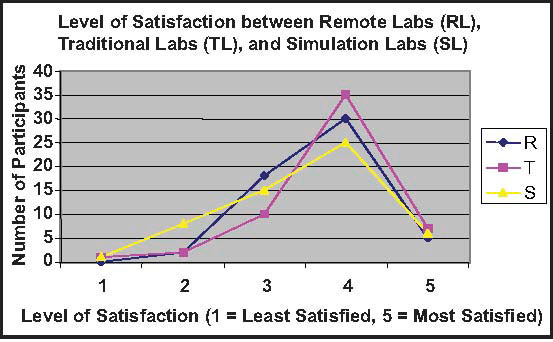
Figure 1. Overall satisfaction with lab types.
Comparing preference for types of labs within a traditional course, labs with simulations rated as most desirable 19 (35.2%), and traditional labs rated the second most desirable 17 (31.5%). It is interesting to note that learners were comfortable with remote labs: 31 (56.4%) rated them desirable, but only 9 (16.7%) rated them most desirable.
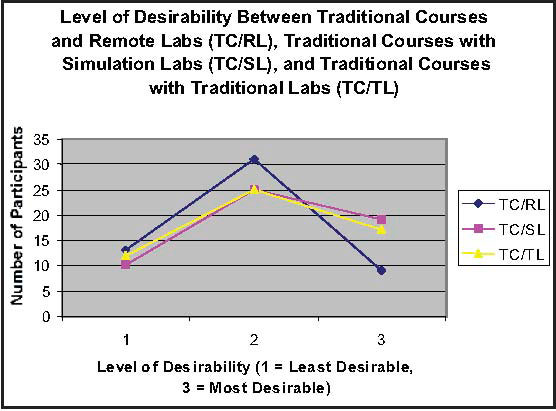
Figure 2. Lab type desirability – traditional courses.
In the online educational environment, simulation labs were also rated most desirable by 22 (40.7%) learners. Remote labs were rated second most desirable by 15 participants (27.8%). Traditional labs were least desirable, with 12 (22.2%) of participants listing them at that level. In this virtual learning environment, accessibility of labs with actual hardware, whether remote or in-person, may influence a learner’s preferences for the type of lab.
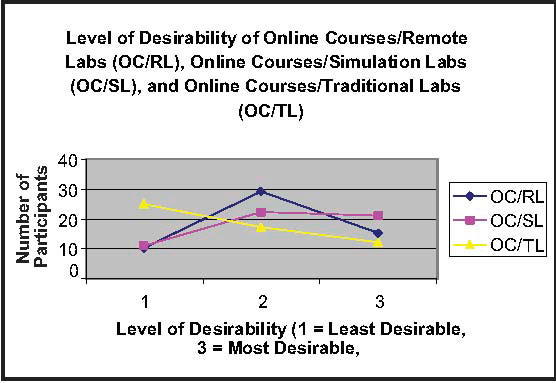
Figure 3. Lab type desirability – online courses.
Importance of Lab Characteristics
To further explore why learners preferred specific types of network labs, the importance of the characteristics of the network labs was analyzed. Responses to survey questions, illustrated in the following figures, asked learners to compare and rate fidelity, usability, and accessibility of the labs. Fidelity is defined as the degree to which the experience of utilizing the network equipment or simulation in the laboratory environment aligns with using it in an actual workplace environment. Usability is defined as the ability of learners to utilize the interface to the equipment or simulation and other features of the laboratory environment. Accessibility is a measure of the availability of the laboratory environment, particularly when learners desire to use it. The results seem to indicate that accessibility is the most important characteristic. In the online environment (Figure 4), accessibility was the key concern, followed by fidelity and then usability. In this environment, being able to readily access the labs appears to be more important than how well they mimic the real environment.
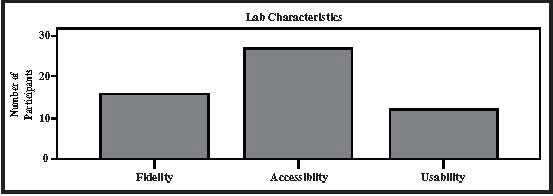
Figure 4. Lab characteristic importance in online course.
Considering both online and traditional courses, usability 23 (40.8%) and accessibility 18 (32.7%) were rated as important lab characteristics (Figure 5). But accessibility remains the primary concern as an essential feature of a networking lab with 21 (38.2%) rating this as essential in importance. It is surprising that fidelity ranked so low. It seems that this characteristic would be rated higher reflecting that learners prefer a more realistic network learning environment. But these results, which consider both the online and traditional environment, indicate that the ability to access and utilize the environment appears to be most important to networking learners.
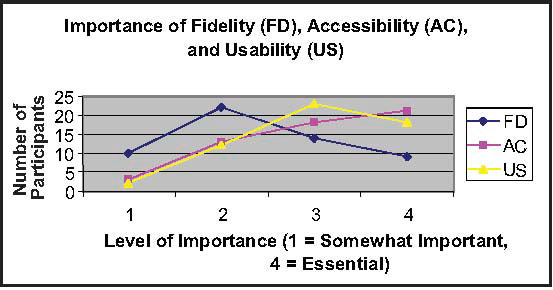
Figure 5. Lab characteristic importance in networking course.
Types of Labs as Related to Learner Characteristics
To investigate whether the prior experience of learners or their academic discipline affected their satisfaction with types of network labs, responses to survey questions rating satisfaction with laboratory types were compared with participants’ work experience in networking and then with their discipline area. From the work experience perspective, participants were categorized into the following levels: (0 years, 1-2 years, 3-4 years, 5-6 years and 7 or more years). A Pearson Chi-Square analysis of the impact of experience on satisfaction for each type of lab (traditional (18.6, df = 16, Sig. .288), remote (14.7, df = 12, Sig. .258), and simulation (23.3, df = 16, Sig. .105) did not yield significant results. This may be partially attributed to the low number of participants ( n = 55) and the requirements that each element in a Chi-Square cross-tabulation table should contain at least five counts. A visual analysis of the results, as illustrated in Figure 6, implies that learners with more experience in networking (7 or more years) favor traditional labs over simulations or remote labs (satisfied + very satisfied participants: traditional = 43, remote = 35 and simulations = 32). Although this provides some support to the notion that adult learners prefer labs that align with prior experience, the lack of a significant result implies more research in this area is needed.
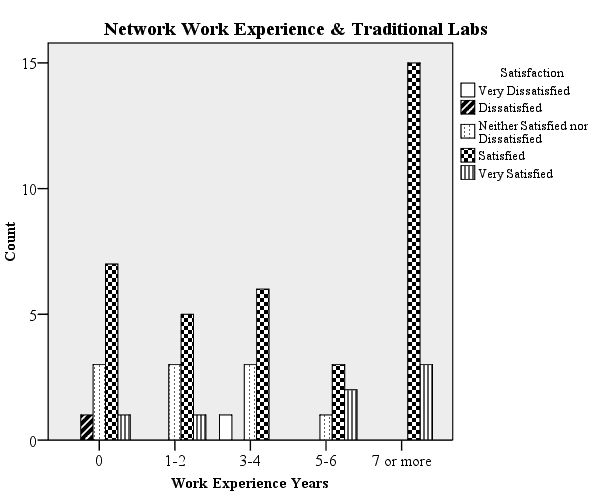
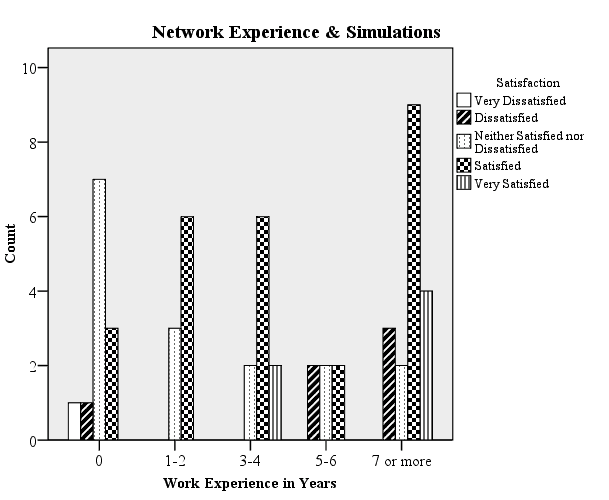
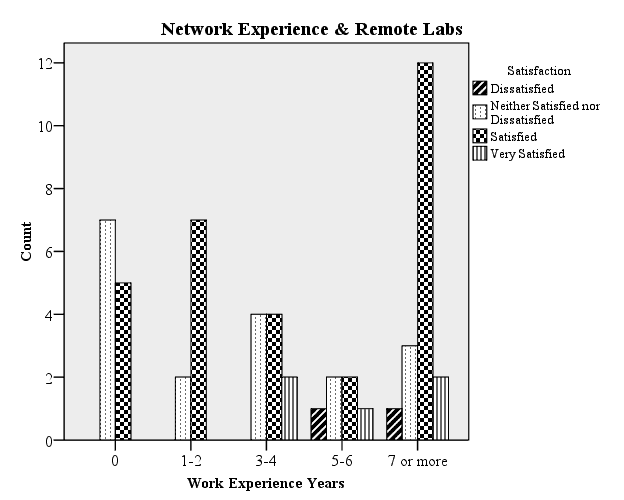
Figure 6. Lab satisfaction related to work experience.
From the discipline perspective, participants were categorized into IT related, networking, business and other disciplines. The expectation was that participants in the networking category would be most satisfied with traditional labs because that category would align most closely to work experience. A Pearson Chi-Square analysis of the affect that discipline has on preference for lab types did not show a significant result for traditional labs (13.204, df = 12, Sig. .354) or for simulations (16.04, df = 12, Sig. .189). However, the affect that the discipline area had on satisfaction for remote labs was borderline significant (16.886, df = 9, Sig. .051). Participants in the IT-related discipline indicated more satisfaction with remote labs (satisfied + very satisfied = 16) to Networking participants(satisfied + very satisfied = 9) or the other discipline areas.
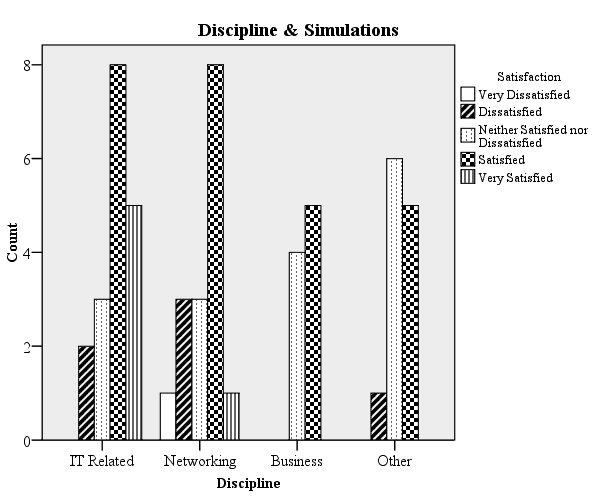
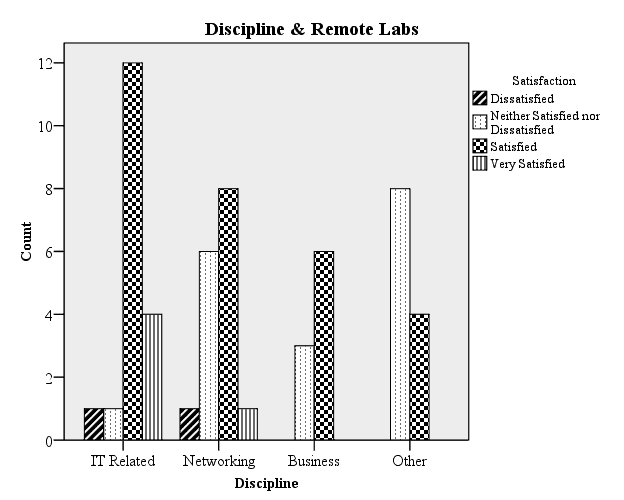
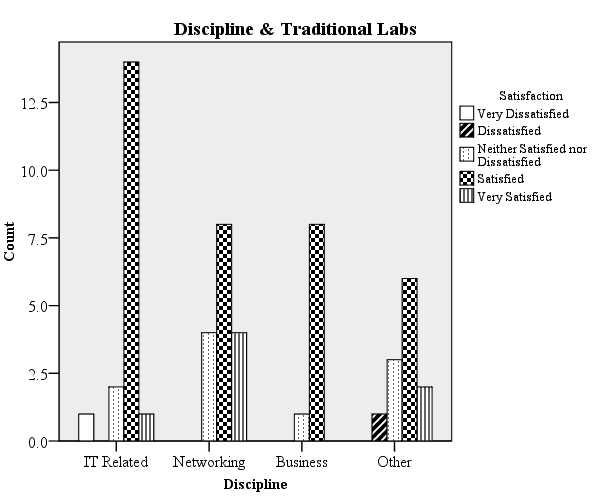
Figure7. Lab satisfaction related to discipline.
Upon further inspection of the results in Table 6, it appears that learners in the academic networking discipline (i.e., networking is their specialization) preferred traditional labs (75.0% satisfied + very satisfied), but that those in related IT areas appeared to prefer remote labs (88.9% satisfied + very satisfied). However, the difference between their satisfaction levels for remote vs. traditional labs is small and inconclusive. Interestingly, learners in business also preferred traditional labs (88.0% satisfied + very satisfied), as did learners in other (non-IT) areas (66.7% satisfied + very satisfied). The stronger satisfaction for traditional labs by networking learners would align with the perspective that labs that more closely mimic “real life” would be preferred by learners with a direct interest in this discipline area.
| Traditional | Remote | Simulation | |
|---|---|---|---|
| Note . Each cell is the percent of the count of satisfaction + very satisfied responses to the total responses for a discipline area. | |||
| IT Related | 83.4% | 88.9% | 72.2% |
| Networking | 75.0% | 56.3% | 56.3% |
| Business | 88.9% | 66.7% | 55.6% |
| Other | 66.7% | 33.3% | 41.7% |
Limitations
As with all research, participants did not represent the entire population of students in networking courses and were limited to a few educational institutions. Laboratory types were limited to simulation software, remote labs, and traditional labs. All participants attended two-year and four-year institutions in the eastern part of the United States that offer both traditional and online courses.
Because this was an exploratory study, a unique survey was developed to determine relationships between student characteristic and lab types. This prevented direct comparisons to results of similar studies. Further, the limited sample size and the exploratory nature of the Likert scale survey questions did not warrant a statistical analysis of the data.
The questions were related to simulation labs and remote labs in general; specific vendors were not indicated. Therefore, the results do not represent any specific vendor or network hardware. Because of the lack of specific information about the lab types, the results must be interpreted from a general characteristic perspective.
Summary
This study highlighted that preference for and satisfaction with types of networking labs are related to several interconnected items, including the characteristics of the labs themselves and the characteristics of learners. The value of the study is in examining these relationships in more detail to discover implications for course design and instruction practice. Considering laboratory types in general it appears that students are more satisfied with traditional labs than remote labs or simulations. However, a different picture appears when the course room environment is considered, or when learner experience and the primary academic area of the students are considered.
In both the online and traditional course room environments, simulations were rated as more desirable then either remote or traditional labs. This seems surprising since one might assume in a traditional environment students would prefer network labs that provided direct hands-on experience with hardware. This assumption is verified to some extent by traditional labs being more desirable (by ratings) than remote labs. However additional characteristics of the lab environment seem to affect how desirable traditional labs are. This factor may be the accessibility of the lab. From the perspective of online courses and networking courses in general (Figure 4 and Figure 5), accessibility was rated the most important characteristic of networking labs. Traditional labs being less desirable may reflect difficulties that students experience in scheduling time for them and technical difficulties experienced while using them. It may reflect similar difficulties students experience when accessing remote labs via the Internet. In the online environment, remote labs were rated second in desirability to simulations, but they were rated higher than traditional labs. This reflects the desire of students to complete all coursework in the online environment, but it indicates that some aspects of the remote labs detract from their desirability in this environment.
Students who are in Networking Technology areas of study have higher levels of satisfaction (i.e., “very satisfied”) than other disciplines when it comes to their experience with traditional labs. In addition, it was observed that learners in IT-related fields (not including networking), have higher levels of satisfaction with remote labs and simulation than learners in other areas of studies. The survey responses also indicate that learners with experience in networking, either through work or discipline area, prefer traditional network labs. However, there appears to be a tendency, particularly among those with less experience, to desire nontraditional labs. This may be explained by the focus on accessibility as a key desired characteristic of labs. Traditional labs may have high fidelity, and depending on the interface to remote labs, they may have high usability. However, fidelity seemed less important than being able to access the labs and complete the lab assignments. Perhaps if the accessibility of remote labs improves, fidelity may play a stronger role in satisfaction.
From a theoretical perspective, these observations align with the tenants of adult learning theory that stipulate the prior experience of the adult learner affects the learning process (i.e., they learn better when the learning experience aligns with prior work experience) ( Knowles, Holton III, & Swanson, 2005 ). Knowles and colleagues (2005) further indicated that the motivation to learn is stronger when the learning tasks relate to the “real life” orientation of the student. Thus, one would expect that students with networking experience or whose discipline area is networking would strongly value labs with the most realistic learning experience. However, it appears that factors such as the accessibility of the labs must be improved to ensure labs of any category can provide a high-quality, desirable experience for adult learners.
To accommodate the differences in preferences for laboratory types between learners based on their level of experience and professional domain, it is recommended that a dual learning path may be most effective. For example, learners who are new to networking or who are not planning to specialize in networking from an academic or career perspective may benefit more from simulation based labs. Those more experienced with networks or who are working in this domain may relate better to remote or virtual network labs that offer an authentic network learning experience.
Recommendations
More research is required to further refine the impacts of how laboratory types and learner characteristics interact in online learning environments. Some of the research areas include studying the effect of gender on various laboratory methodologies; studying the effect of the number of job-related years of experience on the level of satisfaction of utilizing remote labs, simulation software, and traditional labs; and studying the effects of instructor involvement when offering online education courses on the level of satisfaction of learners when each one of the three lab methodologies is used.
Another study with participants from the same institutions is recommended within a year-period to determine if participants’ perspectives toward network labs have changed and how the population has changed in their experiences relative to the labs and learning environments.
Computer networking and the type of networking labs used in its instruction will continue to evolve toward remote and virtual networking interfaces. As this occurs, the borders between traditional labs, remote labs, and simulations will begin to dissolve to support this migration ( Gerdes & Tilley, 2007 ). It will be essential to explore the impact of the change of network technology, particularly virtualization, on the development and instruction of network labs on student satisfaction and learning outcomes.
Dr. Hilmi A. Lahoud is Adjunct Faculty in the School of Business & Technology at Capella University, Minneapolis, Minnesota.
Dr. Jack P. Krichen was the Faculty Chair of the School of Business & Technology at Capella University, Minneapolis, Minnesota
References
Adams, M. A. (2004). Managing open access labs: MacGyver principle. Proceedings of the 32nd Annual ACM SIGUCCS Conference on User Services , (pp. 183 - 187). Baltimore, MD.
Border, C. (2007). The development and deployment of a multi-user, remote access virtualization system for networking, security, and system administration classes. 38th SIGCSE Technical Symposium on Computer Science Education , (pp. 576-580). Covington, Kentucky.
Boson (2008). NetSim: Network Simulator Software. Retrieved from http://www.boson.com/AboutNetSim.html
Brown, S., & Lahoud, H. (2005). An examination of innovative online lab technology. Proceedings of the 2005 ACM Information Technology Education Conference , (pp. 65 - 70). Newark, NJ.
Corter, J. E., Nickerson, J. V., Esche, S. K., Chassapis, D., Im, S., & Ma, J. (2007). Constructing reality: A study of remote, hands-on, and simulated laboratories. ACM Transactions on Computer-Human Interaction , Vol. 14 (pp. 7-27). New York, NY.
ElementK (2008). vLab Virtual Labs ElementK. Retrieved from http://www.elementk.com/index.asp?orgid=392&menuID=378
Gerdes, J., & Tilley, S. (2007). Conceptual overview of the virtual networking laboratory. ACM Information Technology Education Conference , Destin, FL.
Golden, B. (2008). Virtualization for dummies . Hoboken, NJ: Wiley
Knowles, M. S., Holton, E. F. III, & Swanson, R. A. (2005). The adult learner (6th ed.). Burlington, MA: Elsvier
Lahoud, H., & Tang, X. (2006) Information security labs in IDS/IPS for distance education. Proceedings of the 2006 ACM Information Technology Education Conference , (pp. 47-52). Minneapolis, MN.
Lawson, E. A., & Stackpole, W. (2006). Does a virtual networking laboratory result in similar student achievement and satisfaction? Proceedings of the 2006 ACM Information Technology Education Conference , (pp. 105-114). Minneapolis, Minnesota.
Ma, J., & Nickerson, J. V. (2006). Hands-on, simulated, and remote laboratories: A comparative literature review ACM Computing Surveys , Vol. 38. New York, NY.
Network Development Group (2009). NETLAB academic edition, NETLAB. [Retrieved from http://www.netdevgroup.com/ae/overview.htm
Nurul, S. I. (2006). Teaching computer networking fundamentals using practical laboratory exercises. IEEE Transactions on Education , Vol. 49 (pp. 285-291).
Rigby, S., & Dark, M. (2006). Designing a flexible, multipurpose remote lab for the IT curriculum. Proceedings of the 2006 ACM Information Technology Education Conference , (pp. 161-164). Minneapolis, MN.
Schumann, G. (2003). Innovations in teaching plant pathology. Annual Reviews in Phytopathology , Vol. 41 (pp. 377-398).
Tennant, M., & Pogson, P. (1995). Adult education and the reconstruction of experience. In A.B. Knox (Ed), Learning and change in the adult years: A developmental perspective (pp.153-169). San Francisco, CA: Jossey-Bass.
Watts, B., & Becker, W. (2008). A little more than chalk and talk: Results from a third national survey of teaching methods in undergraduate economics courses. Journal of Economic Education, 39, 273-286 .
Wong, K., Wolf, T., Gorinsky, S., & Turner, J. (2007). Teaching experiences with a virtual network laboratory. ACM SIGCSE , (pp. 482-485). Covington, KY.
